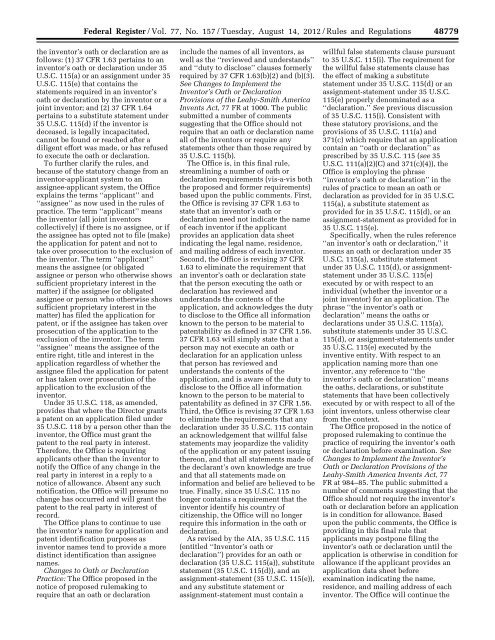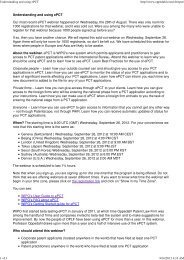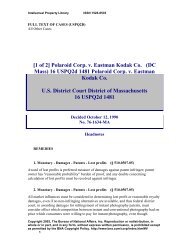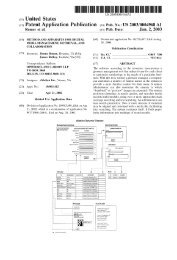sro<strong>be</strong>rts on DSK5SPTVN1PROD with RULES48778 Federal Register / Vol. 77, No. 157 / Tuesday, August 14, 2012 / Rules and RegulationsSection 4(a)(3) of the AIA amends 35U.S.C. 111(a) to insert ‘‘or declaration’’after ‘‘oath.’’ Id.Section 4(b)(1) of the AIA amends 35U.S.C. 118 to change the practiceregarding the filing of an application bya person other than the inventor. First,35 U.S.C. 118 is amended to providethat a person to whom the inventor hasassigned, or is under an obligation toassign, the invention may make anapplication for patent. 125 Stat. at 296.Second, 35 U.S.C. 118 is amended toprovide that a person who otherwiseshows sufficient proprietary interest inthe matter may make an application forpatent on <strong>be</strong>half of and as agent for theinventor on proof of the pertinent factsand a showing that such action isappropriate to preserve the rights of theparties. Id. Under amended 35 U.S.C.118, the Director may continue toprovide whatever notice to the inventorthat the Director considers to <strong>be</strong>sufficient. Id. 35 U.S.C. 118 is alsoamended to provide that if a patent isgranted on an application filed under 35U.S.C. 118, the patent shall <strong>be</strong> grantedto the real party in interest. Id.Amended 35 U.S.C. 116 (35 U.S.C.116(b)) continues to provide that if ajoint inventor refuses to join in anapplication for patent or cannot <strong>be</strong>found or reached after diligent effort,the application may <strong>be</strong> made by theother inventor on <strong>be</strong>half of himself andthe omitted inventor. See 35 U.S.C.116(b). Likewise, 35 U.S.C. 117continues to provide that legalrepresentatives of deceased inventorsand of those under legal incapacity maymake application for patent uponcompliance with the requirements andon the same terms and conditionsapplicable to the inventor. See 35 U.S.C.117.Section 4(b)(2) of the AIA amends 35U.S.C. 251 to provide for the filing of areissue application by an assignee of theentire interest if the application for theoriginal patent was filed by the assigneeof the entire interest. Id.Section 4(c) of the AIA amends 35U.S.C. 112 to change, inter alia, theundesignated paragraphs to subsections.Id. Section 4(d) makes conformingamendments to 35 U.S.C. 111(b) to makereference to the subsections of 35 U.S.C.112. 125 Stat. at 296–97.Section 4(e) of the AIA provides thatthe amendments made by Section 4shall take effect on, and shall apply toany patent application filed on or after,Septem<strong>be</strong>r 16, 2012. 125 Stat. at 297.Section 20 of the AIA amends 35U.S.C. 116, 184, 251, and 256 toeliminate ‘‘without any deceptiveintention’’ clauses from each portion ofthe statute. 125 Stat. at 333–34. Section20 of the AIA provides that itsamendments shall take effect on, andshall apply to proceedings commencedon or after Septem<strong>be</strong>r 16, 2012. 125 Stat.at 335. This change should not <strong>be</strong> takenas an endorsement for applicants andinventors to act with ‘‘deceptiveintention’’ in proceedings <strong>be</strong>fore theOffice. As discussed previously, 35U.S.C. 115(i) requires that anydeclaration or statement filed pursuantto 35 U.S.C. 115 must contain anacknowledgement that any willful falsestatement made in the declaration orstatement is punishable under 18 U.S.C.1001 by fine or imprisonment of notmore than five (5) years, or both.General Discussion RegardingImplementation: The Office proposedchanges and requested comments on thechanges to the rules of practice toimplement section 4 of the AIA in anotice of proposed rulemakingpublished in January 2012. See Changesto Implement the Inventor’s Oath orDeclaration Provisions of the Leahy-Smith America Invents Act, 77 FR 982–1003 (Jan. 6, 2012) (notice of proposedrulemaking). The public submitted anum<strong>be</strong>r of comments suggesting that theOffice take a more robust approach toimplementing the changes in section 4of the AIA, rather than shoehorn thoseprovisions into existing Office practices.In this final rule, the Office is makinga num<strong>be</strong>r of changes to theimplementation of section 4 of the AIAin view of the input from the public.Changes Concerning Who May Applyfor a Patent (the Applicant): The Officetook the position in the notice ofproposed rulemaking that the change to35 U.S.C. 118 did not permit theassignee to <strong>be</strong> the applicant except inthe situations enumerated in 35 U.S.C.115(d)(2). See Changes to Implement theInventor’s Oath or DeclarationProvisions of the Leahy-Smith AmericaInvents Act, 77 FR at 983. The publicsubmitted a num<strong>be</strong>r of commentssuggesting that the changes to 35 U.S.C.118 permit an assignee or an obligatedassignee to <strong>be</strong> the applicant even insituations other than those enumeratedin 35 U.S.C. 115(d)(2). The Office hasrevised the position taken in the noticeof proposed rulemaking based on thepublic comments, and is now taking theposition that the changes to 35 U.S.C.115 and 118 permit an assignee to filean application for patent as theapplicant.35 U.S.C. 118, as amended by theAIA, permits (but does not require) aperson to whom the inventor hasassigned (assignee) or is under anobligation to assign (obligated assignee)the invention to make the applicationfor patent. That section also permits aVerDate Mar2010 17:28 Aug 13, 2012 Jkt 226001 PO 00000 Frm 00004 Fmt 4701 Sfmt 4700 E:\FR\FM\14AUR6.SGM 14AUR6person who otherwise shows sufficientproprietary interest in the matter tomake an application for patent on <strong>be</strong>halfof, and as agent for, the inventor. Thelegislative history of the AIA makesclear that the change to 35 U.S.C. 118is designed to: (1) Make it easier for anassignee to file a patent application; (2)allow obligated assignees (entities towhich the inventor is obligated to assignthe application) to file applications; and(3) allow a person who has a sufficientproprietary interest in the invention tofile an application to preserve thatperson’s rights and those of theinventor. See H.R. Rep. 112–98, at 44(2011). 35 U.S.C. 115, as amended bythe AIA, still requires each inventor toexecute an oath or declaration, except inthe limited circumstances specified in35 U.S.C. 115(d), even if the applicationhas <strong>be</strong>en filed by the assignee or anobligated assignee.Traditionally, <strong>be</strong>ing the applicant (orthe person who may ‘‘make theapplication’’) under 35 U.S.C. chapter11 has <strong>be</strong>en synonymous with <strong>be</strong>ing theperson who must execute the oath ordeclaration under 35 U.S.C. 115.However, 35 U.S.C. 115, as amended bythe AIA, separates the applicant fromthe person who must execute the oathor declaration under 35 U.S.C. 115.Therefore, the Office now reads 35U.S.C. 116, 117, and 118 in view of thepublic comment to specify thecircumstances under which a personother than the inventor may <strong>be</strong> theapplicant, but 35 U.S.C. 115 defineswho must execute the oath ordeclaration that is required by 35 U.S.C.115.As the AIA distinguishes <strong>be</strong>tween the‘‘applicant’’ and the person who mustexecute the oath or declaration under 35U.S.C. 115, the Office is separating theregulations pertaining to <strong>be</strong>ing theapplicant from the regulationspertaining to execution of the inventor’soath or declaration. Specifically, theregulations pertaining to <strong>be</strong>ing theapplicant are as follows: (1) 37 CFR 1.41pertains to inventorship; (2) 37 CFR 1.42pertains to the applicant for patent(which may <strong>be</strong> the inventor or may <strong>be</strong>the assignee); (3) 37 CFR 1.43 pertainsto applications by the legalrepresentative of a deceased or legallyincapacitated inventor; (4) 37 CFR 1.45pertains to joint inventors andapplications by remaining jointinventors; and (5) 37 CFR 1.46 pertainsto applications by the assignee,obligated assignee, or person whootherwise shows sufficient proprietaryinterest in the matter, or to applicationsin which the assignee has taken overprosecution to the exclusion of theinventor. The regulations pertaining to
Federal Register / Vol. 77, No. 157 / Tuesday, August 14, 2012 / Rules and Regulations48779sro<strong>be</strong>rts on DSK5SPTVN1PROD with RULESthe inventor’s oath or declaration are asfollows: (1) 37 CFR 1.63 pertains to aninventor’s oath or declaration under 35U.S.C. 115(a) or an assignment under 35U.S.C. 115(e) that contains thestatements required in an inventor’soath or declaration by the inventor or ajoint inventor; and (2) 37 CFR 1.64pertains to a substitute statement under35 U.S.C. 115(d) if the inventor isdeceased, is legally incapacitated,cannot <strong>be</strong> found or reached after adiligent effort was made, or has refusedto execute the oath or declaration.<strong>To</strong> further clarify the rules, and<strong>be</strong>cause of the statutory change from aninventor-applicant system to anassignee-applicant system, the Officeexplains the terms ‘‘applicant’’ and‘‘assignee’’ as now used in the rules ofpractice. The term ‘‘applicant’’ meansthe inventor (all joint inventorscollectively) if there is no assignee, or ifthe assignee has opted not to file (make)the application for patent and not totake over prosecution to the exclusion ofthe inventor. The term ‘‘applicant’’means the assignee (or obligatedassignee or person who otherwise showssufficient proprietary interest in thematter) if the assignee (or obligatedassignee or person who otherwise showssufficient proprietary interest in thematter) has filed the application forpatent, or if the assignee has taken overprosecution of the application to theexclusion of the inventor. The term‘‘assignee’’ means the assignee of theentire right, title and interest in theapplication regardless of whether theassignee filed the application for patentor has taken over prosecution of theapplication to the exclusion of theinventor.Under 35 U.S.C. 118, as amended,provides that where the Director grantsa patent on an application filed under35 U.S.C. 118 by a person other than theinventor, the Office must grant thepatent to the real party in interest.Therefore, the Office is requiringapplicants other than the inventor tonotify the Office of any change in thereal party in interest in a reply to anotice of allowance. Absent any suchnotification, the Office will presume nochange has occurred and will grant thepatent to the real party in interest ofrecord.The Office plans to continue to usethe inventor’s name for application andpatent identification purposes asinventor names tend to provide a moredistinct identification than assigneenames.Changes to Oath or DeclarationPractice: The Office proposed in thenotice of proposed rulemaking torequire that an oath or declarationinclude the names of all inventors, aswell as the ‘‘reviewed and understands’’and ‘‘duty to disclose’’ clauses formerlyrequired by 37 CFR 1.63(b)(2) and (b)(3).See Changes to Implement theInventor’s Oath or DeclarationProvisions of the Leahy-Smith AmericaInvents Act, 77 FR at 1000. The publicsubmitted a num<strong>be</strong>r of commentssuggesting that the Office should notrequire that an oath or declaration nameall of the inventors or require anystatements other than those required by35 U.S.C. 115(b).The Office is, in this final rule,streamlining a num<strong>be</strong>r of oath ordeclaration requirements (vis-a-vis boththe proposed and former requirements)based upon the public comments. First,the Office is revising 37 CFR 1.63 tostate that an inventor’s oath ordeclaration need not indicate the nameof each inventor if the applicantprovides an application data sheetindicating the legal name, residence,and mailing address of each inventor.Second, the Office is revising 37 CFR1.63 to eliminate the requirement thatan inventor’s oath or declaration statethat the person executing the oath ordeclaration has reviewed andunderstands the contents of theapplication, and acknowledges the dutyto disclose to the Office all informationknown to the person to <strong>be</strong> material topatentability as defined in 37 CFR 1.56.37 CFR 1.63 will simply state that aperson may not execute an oath ordeclaration for an application unlessthat person has reviewed andunderstands the contents of theapplication, and is aware of the duty todisclose to the Office all informationknown to the person to <strong>be</strong> material topatentability as defined in 37 CFR 1.56.Third, the Office is revising 37 CFR 1.63to eliminate the requirements that anydeclaration under 35 U.S.C. 115 containan acknowledgement that willful falsestatements may jeopardize the validityof the application or any patent issuingthereon, and that all statements made ofthe declarant’s own knowledge are trueand that all statements made oninformation and <strong>be</strong>lief are <strong>be</strong>lieved to <strong>be</strong>true. Finally, since 35 U.S.C. 115 nolonger contains a requirement that theinventor identify his country ofcitizenship, the Office will no longerrequire this information in the oath ordeclaration.As revised by the AIA, 35 U.S.C. 115(entitled ‘‘Inventor’s oath ordeclaration’’) provides for an oath ordeclaration (35 U.S.C. 115(a)), substitutestatement (35 U.S.C. 115(d)), and anassignment-statement (35 U.S.C. 115(e)),and any substitute statement orassignment-statement must contain aVerDate Mar2010 17:28 Aug 13, 2012 Jkt 226001 PO 00000 Frm 00005 Fmt 4701 Sfmt 4700 E:\FR\FM\14AUR6.SGM 14AUR6willful false statements clause pursuantto 35 U.S.C. 115(i). The requirement forthe willful false statements clause hasthe effect of making a substitutestatement under 35 U.S.C. 115(d) or anassignment-statement under 35 U.S.C.115(e) properly denominated as a‘‘declaration.’’ See previous discussionof 35 U.S.C. 115(i). Consistent withthese statutory provisions, and theprovisions of 35 U.S.C. 111(a) and371(c) which require that an applicationcontain an ‘‘oath or declaration’’ asprescri<strong>be</strong>d by 35 U.S.C. 115 (see 35U.S.C. 111(a)(2)(C) and 371(c)(4)), theOffice is employing the phrase‘‘inventor’s oath or declaration’’ in therules of practice to mean an oath ordeclaration as provided for in 35 U.S.C.115(a), a substitute statement asprovided for in 35 U.S.C. 115(d), or anassignment-statement as provided for in35 U.S.C. 115(e).Specifically, when the rules reference‘‘an inventor’s oath or declaration,’’ itmeans an oath or declaration under 35U.S.C. 115(a), substitute statementunder 35 U.S.C. 115(d), or assignmentstatementunder 35 U.S.C. 115(e)executed by or with respect to anindividual (whether the inventor or ajoint inventor) for an application. Thephrase ‘‘the inventor’s oath ordeclaration’’ means the oaths ordeclarations under 35 U.S.C. 115(a),substitute statements under 35 U.S.C.115(d), or assignment-statements under35 U.S.C. 115(e) executed by theinventive entity. With respect to anapplication naming more than oneinventor, any reference to ‘‘theinventor’s oath or declaration’’ meansthe oaths, declarations, or substitutestatements that have <strong>be</strong>en collectivelyexecuted by or with respect to all of thejoint inventors, unless otherwise clearfrom the context.The Office proposed in the notice ofproposed rulemaking to continue thepractice of requiring the inventor’s oathor declaration <strong>be</strong>fore examination. SeeChanges to Implement the Inventor’sOath or Declaration Provisions of theLeahy-Smith America Invents Act, 77FR at 984–85. The public submitted anum<strong>be</strong>r of comments suggesting that theOffice should not require the inventor’soath or declaration <strong>be</strong>fore an applicationis in condition for allowance. Basedupon the public comments, the Office isproviding in this final rule thatapplicants may postpone filing theinventor’s oath or declaration until theapplication is otherwise in condition forallowance if the applicant provides anapplication data sheet <strong>be</strong>foreexamination indicating the name,residence, and mailing address of eachinventor. The Office will continue the
- Page 1:
UNIFORM CERTIFICATE OF ATTENDANCE F
- Page 4 and 5: SPTO explains the America Invents A
- Page 6 and 7: PTO/SB/01A (01-09)Approved for use
- Page 8 and 9: PTO/SB/ (06-12)Approved for use thr
- Page 10 and 11: PTO/ (06-12)Approved for use throug
- Page 12 and 13: PTO/(06-1Approved for use through 0
- Page 14 and 15: What will change about the oath ord
- Page 16 and 17: Action item●●●If you have not
- Page 18 and 19: But 37 CFR § 1.63 says:A person ma
- Page 20 and 21: ●●●Combined assignment anddec
- Page 22 and 23: ●●●●●●Consequences of i
- Page 24 and 25: How to file the ADSs●●If you pr
- Page 26 and 27: Supplemental ADSAny ADS filed after
- Page 28 and 29: Provisionals●●●Rules are a bi
- Page 30 and 31: Are all assignees applicants?●●
- Page 32 and 33: Substitute Statement●●●This f
- Page 34 and 35: ●●●Docket consequences of the
- Page 36 and 37: New Rule-46 practice67●●●Rule
- Page 38 and 39: Consequences of AIA for PCT filers
- Page 40 and 41: If you are entrusted the US nationa
- Page 42 and 43: ●●●Choosing between a “bypa
- Page 44 and 45: ●●●Getting your name and addr
- Page 46 and 47: Exercises relating to September 16,
- Page 48 and 49: Important AIA webinar September 6
- Page 50 and 51: Exercises relating to September 16,
- Page 52 and 53: 48776 Federal Register / Vol. 77, N
- Page 56 and 57: sroberts on DSK5SPTVN1PROD with RUL
- Page 58 and 59: sroberts on DSK5SPTVN1PROD with RUL
- Page 60 and 61: sroberts on DSK5SPTVN1PROD with RUL
- Page 62 and 63: sroberts on DSK5SPTVN1PROD with RUL
- Page 64 and 65: sroberts on DSK5SPTVN1PROD with RUL
- Page 66 and 67: sroberts on DSK5SPTVN1PROD with RUL
- Page 68 and 69: sroberts on DSK5SPTVN1PROD with RUL
- Page 70 and 71: sroberts on DSK5SPTVN1PROD with RUL
- Page 72 and 73: sroberts on DSK5SPTVN1PROD with RUL
- Page 74 and 75: 48798 Federal Register / Vol. 77, N
- Page 76 and 77: 48800 Federal Register / Vol. 77, N
- Page 78 and 79: 48802 Federal Register / Vol. 77, N
- Page 80 and 81: 48804 Federal Register / Vol. 77, N
- Page 82 and 83: 48806 Federal Register / Vol. 77, N
- Page 84 and 85: 48808 Federal Register / Vol. 77, N
- Page 86 and 87: 48810 Federal Register / Vol. 77, N
- Page 88 and 89: 48812 Federal Register / Vol. 77, N
- Page 90 and 91: 48814 Federal Register / Vol. 77, N
- Page 92 and 93: 48816 Federal Register / Vol. 77, N
- Page 94 and 95: sroberts on DSK5SPTVN1PROD with RUL
- Page 96 and 97: sroberts on DSK5SPTVN1PROD with RUL
- Page 98 and 99: 48822 Federal Register / Vol. 77, N
- Page 100 and 101: sroberts on DSK5SPTVN1PROD with RUL
- Page 102: 48826 Federal Register / Vol. 77, N





